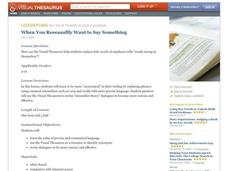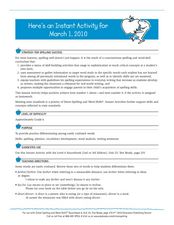Curated OER
Phonological Awareness and Rhyming
Students listen to a story and chime whenever they hear rhyming word pairs. Students generate other rhyming words that rhyme with each pair from the story. Students draw and/or paint illustrations to go along with a rhyming song given....
Curated OER
Language Arts: Who Am I?
Twelfth graders write self-identity essays of three to five paragraphs in length. They include topic sentences, transition words, and concluding paragraphs in their essays, They read their essays to classmates.
Southern Nevada Regional Professional Development Program
Reading Literature - Romeo and Juliet
“What is the theme of this story?” Now there’s a question all pupils dread. Rather than encountering a sea of faces that look like they were painted by Edward Munch, face a classroom filled with smiles and confidence. Show your readers...
Northeast Foundation for Children, Inc.
Classroom Setup: Grade 3
There's a lot of thought that goes into setting up safe and supportive classroom environments. From establishing a whole group meeting area and arranging desks, to organizing classroom supplies and creating bulletin board displays, this...
Core Knowledge Foundation
The Five Senses Tell It Again!™ Read-Aloud Anthology
Young readers explore the five senses with a read-aloud anthology. Each lesson follows the routine of introducing the reading, listening to a read-aloud, answering comprehension questions, then practicing a skill. Modification and...
Core Knowledge Foundation
Farms Tell It Again!™ Read-Aloud Anthology
The thematic read-aloud anthology introduces young readers to life on a farm. The thoughtfully detailed resource offers three weeks of skills practice designed to boost reading comprehension skills. Lessons follow a routine of...
School Magazine
Horrible Homonyms!
Park/park, spring/spring. do your class members need extra practice with homonyms? The first exercise on this worksheeet asks learners to identify the homonym, while the second asks kids to identify at least two meanings of the word listed.
Novelinks
Maus: Bingo Vacabulary Strategy
The definitions for unfamiliar words drawn from Art Spiegelman graphic novel memoir, Maus, provide the clues for a vocabulary bingo game.
Curated OER
When You Reeeaaallly Want to Say Something
Kids paraphrase an entry from The Elements of Style, and then revise a sentence. They use the Visual Thesaurus and find synonyms for the phrase very pretty, brainstorm a list of intensifiers (as alternatives to really and very), then...
Curated OER
Grab Your Reader: Great Leads
Get your readers' attention with this Six Traits of Writing lesson plan. First, young writers draft ideas in an organized manner utilizing words, sentences, and multiple paragraphs. They also use voice to fit the purpose and audience and...
Curated OER
Word Power
Fifth graders identify a set of data from a real world problem. For this statistics lesson, 5th graders identify the range, mode, median and mean using some manipulatives. They write words randomizing the letters.
Curated OER
Rollin’ on the River: Identifying Jargon
Students identify jargon in poetry, prose and fiction. In this literature lesson, students will read selections from Mark Twain and identify figurative langauge, focusing on jargon.
Curated OER
Synonyms: Meanings from Context
In this synonym worksheet, students use context to help identify a synonym in a short passage for a word that has been highlighted, 6 passages total.
Curated OER
Appreciating the Language and Interpreting the Meaning of Hamlet's Soliloquy
Students analyze Hamlet's soliloquy, "To be or not to be." In this Hamlet lesson, students define unfamiliar words in the soliloquy and interpret the lines. Students then read the lines aloud and identify descriptive words. Students...
Curated OER
Jambo Means Hello: An Introduction To Swahili
Students gain an appreciation for Swahili as a language spoken in many parts of Africa. They share and illustrate words from their own culture using English and Swahili and others to create a word quilt.
Curated OER
Words Ending in Soft g
Fifth graders complete a worksheet. In this sound identification lesson, 5th graders distinguish between a soft g and a hard g sound and identify words with each. Students complete a worksheet where they write and identify words with...
Curated OER
BBC Learning English, Speaking (Clarifying Meaning)
In this verbal comprehension learning exercise, learners identify possible reasons for poor inter-personal communication and learn multiple phrases to use for clarification in a conversation.
Curated OER
Practice Easily Confused Words
Sixth graders review vocabulary words. In this spelling activity, 6th graders review words that are easily confused. Students complete an activity at home for practice.
Curated OER
Identifying Irony
In this identifying irony worksheet, 9th graders read 6 paragraphs, identify the type of irony being used (dramatic, situational, verbal) and explain their answer.
Curated OER
DNA: What Does It Mean?
Tenth graders explore DNA using online tutorial. They perform their own DNA extraction from a clove of garlic and identify the key components of DNA.
Curated OER
ESOL: Pronouncing Multi-Syllable Words
Twelfth graders in an ESOL class discover where to place the stress in multi-syllable words. Through drill and practice sessions they identify a variety of stress patterns for words containing multi-syllables. In pairs, 12th graders...
National First Ladies' Library
What Does It Mean to Give Your Time?
High schoolers identify and consider what it means to sacrifice time and effort in helping others. Then they decide areas where their help may be needed, and pursue this area in the local community. Students also search the World Wide...
Smithsonian Institution
In His Own Words: George Washington Quotation Timeline
Students read and analyze a series of excerpts from George Washington's letters, journal, and speeches to match quotations to the event or date in his life. They identify the author or source of the historical document or narrative. They...
Alabama Learning Exchange
Nouns, Verbs, and Describing Words
Second graders photograph items in their school and write a sentence that describes the items. They use different colored fonts when word processing the sentence to highlight nouns, verbs, and adjectives.

























